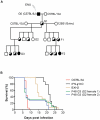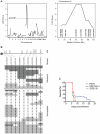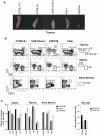An N-ethyl-N-nitrosourea (ENU)-induced dominant negative mutation in the JAK3 kinase protects against cerebral malaria
- PMID: 22363534
- PMCID: PMC3283600
- DOI: 10.1371/journal.pone.0031012
An N-ethyl-N-nitrosourea (ENU)-induced dominant negative mutation in the JAK3 kinase protects against cerebral malaria
Abstract
Cerebral malaria (CM) is a lethal neurological complication of malaria. We implemented a genome-wide screen in mutagenized mice to identify host proteins involved in CM pathogenesis and whose inhibition may be of therapeutic value. One pedigree (P48) segregated a resistance trait whose CM-protective effect was fully penetrant, mapped to chromosome 8, and identified by genome sequencing as homozygosity for a mis-sense mutation (W81R) in the FERM domain of Janus-associated kinase 3 (Jak3). The causative effect of Jak3(W81R) was verified by complementation testing in Jak3(W81R/-) double heterozygotes that were fully protected against CM. Jak3(W81R) homozygotes showed defects in thymic development with depletion of CD8(+) T cell, B cell, and NK cell compartments, and defective T cell-dependent production of IFN-γ. Adoptive transfer of normal splenocytes abrogates CM resistance in Jak3(W81R) homozygotes, an effect attributed to the CD8(+) T cells. Jak3(W81R) behaves as a dominant negative variant, with significant CM resistance of Jak3(W81R/+) heterozygotes, compared to CM-susceptible Jak3(+/+) and Jak3(+/-) controls. CM resistance in Jak3(W81R/+) heterozygotes occurs in presence of normal T, B and NK cell numbers. These findings highlight the pathological role of CD8(+) T cells and Jak3-dependent IFN-γ-mediated Th1 responses in CM pathogenesis.
Conflict of interest statement
Figures







Similar articles
-
Susceptibility to lethal cerebral malaria is regulated by epistatic interaction between chromosome 4 (Berr6) and chromosome 1 (Berr7) loci in mice.Genes Immun. 2013 Jun;14(4):249-57. doi: 10.1038/gene.2013.16. Epub 2013 Apr 18. Genes Immun. 2013. PMID: 23594960
-
CCDC88B is a novel regulator of maturation and effector functions of T cells during pathological inflammation.J Exp Med. 2014 Dec 15;211(13):2519-35. doi: 10.1084/jem.20140455. Epub 2014 Nov 17. J Exp Med. 2014. PMID: 25403443 Free PMC article.
-
Partial trisomy 21 contributes to T-cell malignancies induced by JAK3-activating mutations in murine models.Blood Adv. 2018 Jul 10;2(13):1616-1627. doi: 10.1182/bloodadvances.2018016089. Blood Adv. 2018. PMID: 29986854 Free PMC article.
-
ZBTB7B (ThPOK) Is Required for Pathogenesis of Cerebral Malaria and Protection against Pulmonary Tuberculosis.Infect Immun. 2020 Jan 22;88(2):e00845-19. doi: 10.1128/IAI.00845-19. Print 2020 Jan 22. Infect Immun. 2020. PMID: 31792077 Free PMC article.
-
Genetic analysis of cerebral malaria in the mouse model infected with Plasmodium berghei.Mamm Genome. 2018 Aug;29(7-8):488-506. doi: 10.1007/s00335-018-9752-9. Epub 2018 Jun 19. Mamm Genome. 2018. PMID: 29922917 Review.
Cited by
-
Irf8-regulated genomic responses drive pathological inflammation during cerebral malaria.PLoS Pathog. 2013;9(7):e1003491. doi: 10.1371/journal.ppat.1003491. Epub 2013 Jul 11. PLoS Pathog. 2013. PMID: 23853600 Free PMC article.
-
Genome-wide mouse mutagenesis reveals CD45-mediated T cell function as critical in protective immunity to HSV-1.PLoS Pathog. 2013 Sep;9(9):e1003637. doi: 10.1371/journal.ppat.1003637. Epub 2013 Sep 12. PLoS Pathog. 2013. PMID: 24068938 Free PMC article.
-
Host genetics in malaria: lessons from mouse studies.Mamm Genome. 2018 Aug;29(7-8):507-522. doi: 10.1007/s00335-018-9744-9. Epub 2018 Mar 28. Mamm Genome. 2018. PMID: 29594458 Review.
-
KCC1 Activation protects Mice from the Development of Experimental Cerebral Malaria.Sci Rep. 2019 Apr 23;9(1):6356. doi: 10.1038/s41598-019-42782-x. Sci Rep. 2019. PMID: 31015511 Free PMC article.
-
USP15 regulates type I interferon response and is required for pathogenesis of neuroinflammation.Nat Immunol. 2017 Jan;18(1):54-63. doi: 10.1038/ni.3581. Epub 2016 Oct 10. Nat Immunol. 2017. PMID: 27721430
References
-
- WHO website. Available: http://www.who.int/features/factfiles/malaria/en/index.html. Accessed 2009 March.
-
- Hunt NH, Grau GE. Cytokines: accelerators and brakes in the pathogenesis of cerebral malaria. Trends Immunol. 2003;24:491–499. - PubMed
-
- Bongfen SE, Laroque A, Berghout J, Gros P. Genetic and genomic analyses of host-pathogen interactions in malaria. Trends Parasitol. 2009;25:417–422. - PubMed
-
- Kwiatkowski D. Genetic susceptibility to malaria getting complex. Curr Opin Genet Dev. 2000;10:320–324. - PubMed
-
- Weatherall DJ. Genetic variation and susceptibility to infection: the red cell and malaria. Br J Haematol. 2008;141:276–286. - PubMed
Publication types
MeSH terms
Substances
Grants and funding
LinkOut - more resources
Full Text Sources
Other Literature Sources
Molecular Biology Databases
Research Materials

